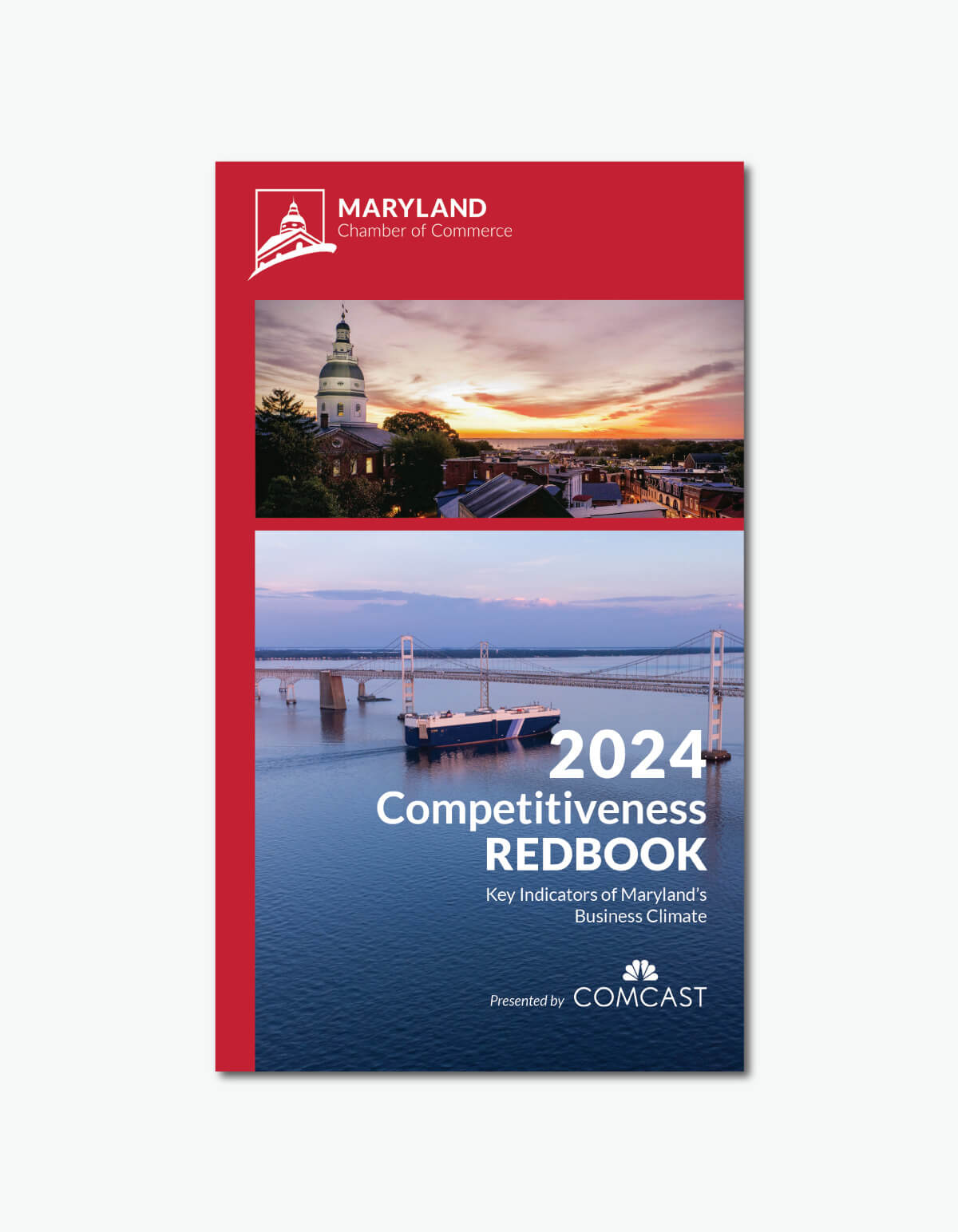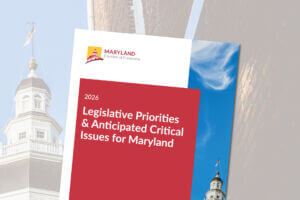Blog
Charting Maryland’s Economic Competitiveness in 2024: Business Friendliness
Oct 9, 2024
Examining Business Friendliness in Maryland
Maryland's alarming drop from 22nd to 31st in CNBC's 2024 Top States for Business rankings, coupled with 32nd place in U.S. News' Business Environment rankings, signals a clear and urgent threat to our state's economic competitiveness.
Challenges to Competitiveness
Overall Ranking Decline: Maryland fell from 22nd to 31st in CNBC's 2024 Top States for Business rankings, a signal of a critical loss of competitiveness across multiple factors that businesses consider when deciding where to locate and grow.
Deteriorating Business Climate: Maryland’s drop from 24th to 37th in business friendliness highlights a weakening environment that discourages new investments and expansions. This ultimately means fewer businesses who will be willing to invest in Maryland, fewer jobs being created and less revenue to support public services.
Infrastructure Deficiencies: Maryland’s decline from 15th to 37th in CNBC’s infrastructure ranking — which encompasses factors including roads, bridges, ports, airports, utilities and development sites, underscores urgent needs in infrastructure improvements. The Key Bridge collapse vividly illustrates the dire impact of infrastructure on our economy and business climate. Without a strong infrastructure, businesses cannot operate efficiently, and the state's economy suffers.
Prohibitive Costs of Doing Business: Ranking 47th nationally, Maryland is the fourth most expensive state for business operations. This high-cost environment, coupled with challenges in infrastructure, workforce, and taxes, hampers business retention, growth, and investment. For business leaders, this means tighter margins and tougher decisions on where to expand or even stay. For policymakers, this translates to a need for urgent reform to keep Maryland competitive.
Stagnant Workforce Development: Maryland's workforce ranking remains unchanged at 28th, signaling concerns for job creators investing in Maryland. The U.S. Chamber of Commerce reports Maryland has only 33 available workers for every 100 open jobs, making it difficult for businesses to operate at full capacity or grow in our state.
Regional Competition: Neighboring Virginia (1st overall) and Pennsylvania (17th overall) outperform Maryland in key areas, presenting stark competition for business investment. Virginia's consistent top rankings as a top state for business emphasize the need for Maryland to adopt strategic improvements and capitalize on available opportunities to regain our competitive standing.
CNBC’s Top States for Business: July 2024
| Md '22 | Md '23 | Md '24 | Va '23 | Pa '23 | De '23 | Best | |
| Overall | 27 | 22 | ↓ 31 | 1 | 17 | 34 | Virginia |
| Business Friendliness | 29 | 24 | ↓ 37 | 5 | 41 | 46 | N. Dakota |
| Infrastructure | 22 | 15 | ↓ 37 | 3 | 22 | 23 | Georgia |
| Workforce | 10 | 28 | ≡ 28 | 9 | 35 | 7 | Texas |
| Cost of Business | 44 | 47 | ≡ 47 | 24 | 27 | 44 | W. Virginia |
| Economy | 31 | 31 | ↑ 30 | 11 | 34 | 10 | Florida |
| Quality of Life | 18 | 11 | ↓ 16 | 19 | 25 | 27 | Vermont |
| Tech & Innovation | 14 | 7 | ↓ 8 | 15 | 7 | 35 | Calif., Mass. |
| Education | 18 | 21 | ↑ 14 | 1 | 3 | 45 | Virginia |
| Cost of Living | 44 | 27 | ↑ 24 | 19 | 7 | 14 | Iowa |
| Access to Capital | 13 | 13 | ↓ 16 | 8 | 5 | 26 | Texas |
Data Trends
Maryland dropped nine places in CNBC’s Best States for Business overall rankings, moving from 22nd in 2023 to 31st in 2024. Significant declines were noted in business friendliness, where Maryland fell 13 spots to 37th, and in infrastructure, where it plummeted 22 spots to 37th.
CNBC’s 2024 rankings placed the most emphasis on infrastructure, which includes factors like roads, bridges, ports, airports, utilities, and development sites. This is a shift from previous years when workforce metrics were weighted most heavily. Maryland’s steep decline in infrastructure highlights an urgent need for improvements in this area.
Maryland’s workforce ranking held steady at 28th, while the cost of doing business remained unchanged at 47th, placing Maryland among the most expensive states in the country for businesses.
The state saw slight gains in its economy ranking, which improved to 30th from 31st in 2023; education, which climbed to 14th from 21st; and cost of living, which moved up to 24th from 27th.
While Maryland continues to rank relatively well in quality of life (16th), tech and innovation (8th), and access to capital (16th), there are signs that the state is losing ground in these areas compared to its peers.
Working Towards a Solution
To reverse these trends and boost Maryland's competitiveness, we propose four solutions-oriented approaches:
Improve Business Friendliness: Streamline regulations, create a more predictable regulatory environment, and review business-related fees for potential reductions. Business leaders need a clear, consistent framework to operate within, while policymakers should focus on reducing barriers to business success.
Enhance Infrastructure: Implement permitting reform, ease construction regulations, and prioritize efficient systems across all sectors. Businesses rely on strong infrastructure to move goods, connect with customers, and grow. Policymakers must prioritize infrastructure as a foundation for economic growth.
Adopt Tax Reforms: Consider cuts to the corporate tax rate to stimulate business growth and investment, expanding the overall tax base through increased economic activity.
Enhance Our Workforce: Attract and retain residents through programs like military retirement tax credits, and support workforce development to meet evolving industry needs. A skilled and adaptable workforce is the backbone of business success, and building a steady pipeline of talent is crucial for Maryland's long-term economic growth.
These strategies aim to reverse Maryland's declining competitiveness and create a thriving economy that benefits all residents. By focusing on these key areas, we can make Maryland more business-friendly and, in turn, cultivate an environment that attracts residents, broadens the tax base, and supports sustained economic growth.
However, if we fail to recognize the warning signs and allow our state to be perceived as costly and unfriendly to businesses, we risk facing even more alarming trends. People and businesses have choices—we must ensure Maryland is the place they choose. By tackling these challenges head-on, we can secure Maryland's economic future and create a state where all businesses and their communities can thrive.
Sources
Key Takeaways
Our neighbors are outpacing and outranking us, creating a pressing need for action. Without immediate improvements, Maryland will continue to lose ground, making it increasingly difficult to attract and retain businesses and talent.
Immediate steps must be taken to address declining rankings and foster a more business-friendly environment. Failure to act now will result in long-term economic challenges that will be increasingly difficult to overcome. For business leaders, this means advocating for change; for policymakers, it means implementing policies that make Maryland a more attractive place to do business.
Maryland's competitiveness is in steep decline, facing mounting challenges like domestic migration to other states, a stagnant population, lackluster business growth and a growing budget deficit. If we do not act now, these challenges will lead to a deteriorating economy, diminished job creation and further budgetary challenges for our state.
Why it Matters
A business-friendly environment is the cornerstone of a strong, prosperous state. Businesses drive job creation, encourage investment and sustain a robust tax base. Thriving businesses generate opportunities for all Marylanders, fostering community growth, individual success and a much more resilient economy.
For business leaders, these rankings are a direct indicator of where to invest and expand. For policymakers, these numbers reveal the broader economic health of the state. If we fail to address these declines, Maryland risks facing a deteriorating economy, decreased job opportunities and a shrinking tax base. The long-term consequences would be severe: a weakened economic position that would make it increasingly difficult to compete on a national scale.
Additional Reading
Top States for Business: Maryland (CNBC, 2023)
Best States for Business (Forbes)
Best States for Economy (U.S. News)
Examining latest movements in state economic growth and competition (Rich States, Poor States)
Freedom in the 50 States, an Index of Personal and Economic Freedom (The Cato Institute)
Ranked: The Best States To Start a Business In 2024 (Forbes, 2024)




